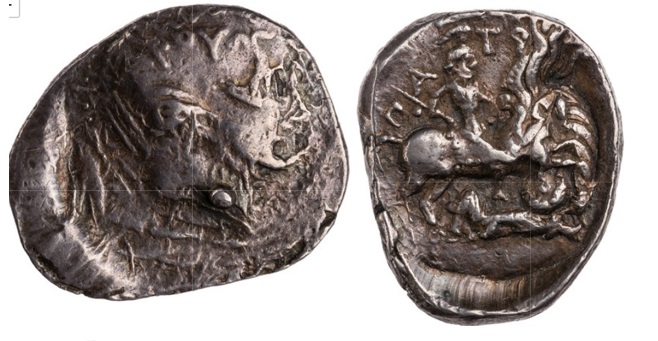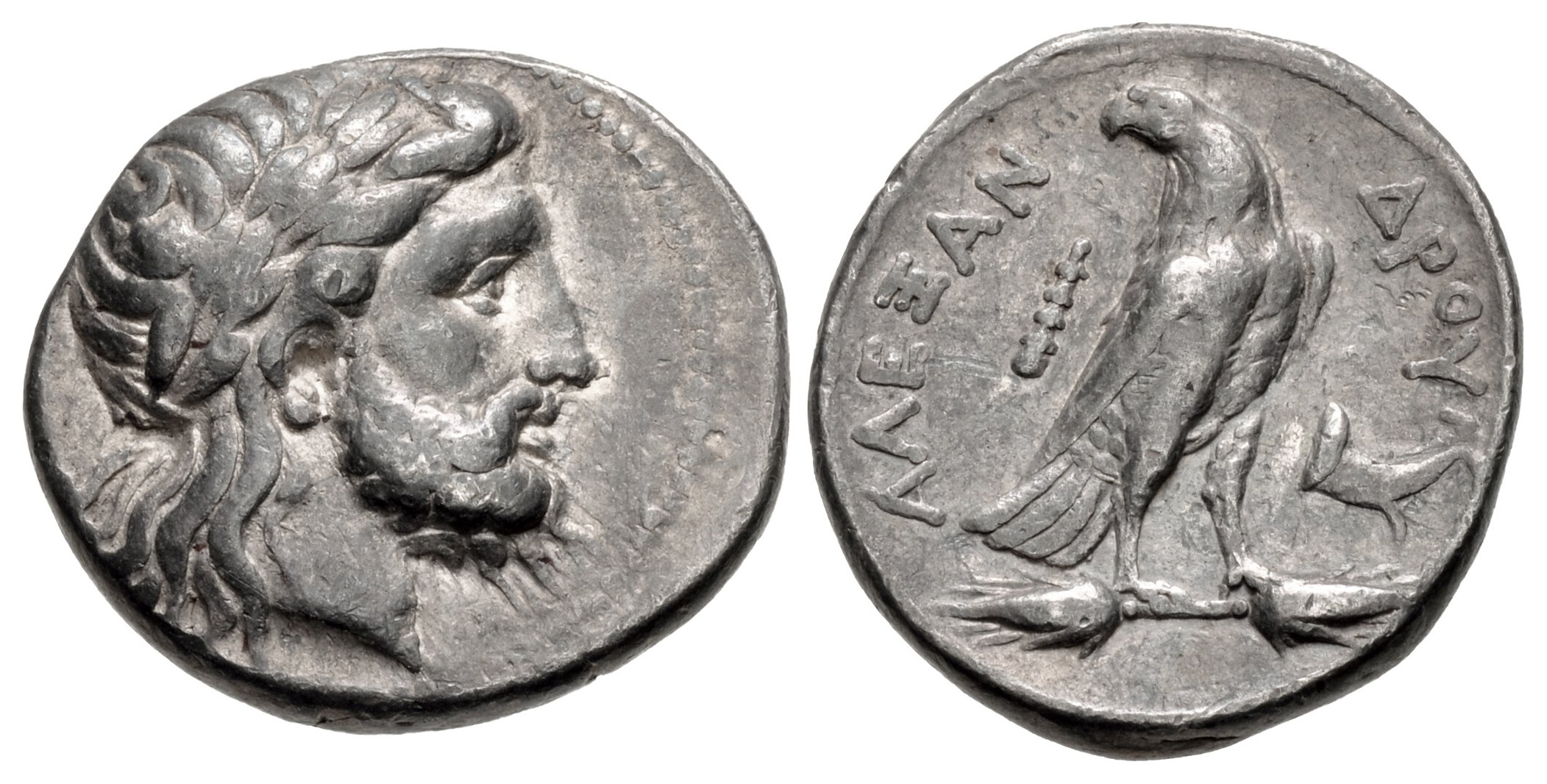2894 - Paeonia (uncertain mint) (Patraus) (tetradrachm Apollo/rider) over Alexander the Great (Zeus/eagle) (New York, ANS, 1971.196.1): Difference between revisions
From SILVER
No edit summary |
|||
| Line 11: | Line 11: | ||
|Reverse legend language=Greek | |Reverse legend language=Greek | ||
|Reverse description=Paionian cavaleryman on horseback right, spearing Macedonian enemy lying below who defends himself with shield. | |Reverse description=Paionian cavaleryman on horseback right, spearing Macedonian enemy lying below who defends himself with shield. | ||
|Mint= | |Mint=Paeonia (uncertain mint) | ||
|Ancient region= | |Ancient region=Paeonia | ||
|Authority=Patraus (king of Peonia, 340-315 BC) | |Authority=Patraus (king of Peonia, 340-315 BC); Paeonian kingdom | ||
|Date from=329 BCE | |Date from=329 BCE | ||
|Date to=315 BCE | |Date to=315 BCE | ||
Revision as of 16:10, 29 May 2023
329 BCE - 315 BCE | ΠΑΤΡΑΟΥ
Location/history
| Museum collectionMuseum collection: | New York, ANS, 1971.196.1 | Sale(s)Sale(s) ᵖ: | Dorotheum, 24, Oct. 1961, 461 |
| Private collection(s)Private collection(s) ᵖ: | Hollschek collection |
Overstriking coin
Description
| ObverseInscription or printing placed on the obverse.: | Head of Apollo right, wearing laurel wreath. | ReverseInscription or printing placed on the reverse.: | ΠΑΤΡΑΟΥ (Greek) Paionian cavaleryman on horseback right, spearing Macedonian enemy lying below who defends himself with shield. |
Mint and issuing power
| MintIdentifies the place of manufacture or issue of a numismatic object.: | Paeonia (uncertain mint) | Ancient regionAncient region. | Paeonia | Modern countryModern country: | AuthorityIdentifies the issuing power. The authority can be "pretended" when the name or the portrait of X is on the coin but he/she was not the issuing power. It can also be "uncertain" when there is no mention of X on the coin but he/she was the issuing power according to the historical sources: | Patraus (king of Peonia, 340-315 BC), Paeonian kingdom |
Chronology
| FromIdentifies the initial date in a range assigned in a numismatic context. 329 BCE toIdentifies the final date in a range assigned in a numismatic context.. 315 BCE | Hellenistic 323-30 BC |
Physical description
| MetalThe physical material (usually metal) from which an object is made.: Silver |
WeightWeight of the numismatic object (in grams). in grams: 12.4912.49 g <br />12,490 mg <br /> | DenominationTerm indicating the value of a numismatic object. Examples: tetradrachm, chalkous, denarius.: tetradrachm |
AxisDescribes the directional relationship between the obverse and reverse of a numismatic object.: 1212 mm <br />1.2 cm <br /> |
| StandardStandard.: Thraco-Macedonian | |||
References
| Coin referenceReference of the Coin: | Pegan 1968 | Coin series referenceReference to coin series study: | Pegan 19681Pegan 1968, Sear I2Sear I, n° 1520, HGC 3.23HGC 3.2, n° 148 |
| Coin series web referenceCoin series web references: | |||
Overstruck type
Description
| ObverseInscription or printing placed on the obverse.: | Head of Zeus right, wearing laurel wreath. | ReverseInscription or printing placed on the reverse.: | AΛΕΞΑΝΔΡΟΥ (Greek) Eagle right on thunderbolt, head left. In field, aplastron and bee? |
Mint and issuing power
| MintIdentifies the place of manufacture or issue of a numismatic object. ᵖ: | Ancient regionAncient region. ᵖ | Macedon | Modern countryModern country: | AuthorityIdentifies the authority in whose name (explicitly or implicitly) a numismatic object was issued. ᵖ: | Alexander III the Great (Argead king, 336-323 BC) |
Chronology
| FromIdentifies the initial date in a range assigned in a numismatic context. 336 BCE toIdentifies the final date in a range assigned in a numismatic context.. 334 BCE | Classical 480-323 BC |
Physical description
| DenominationTerm indicating the value of a numismatic object. Examples: tetradrachm, chalkous, denarius. ᵖ: | tetradrachm |
StandardStandard. ᵖ: | Thraco-Macedonian |
References
| Coin type referenceReference to coin series study ᵖ: |
Additional data
| Frequency of overstrikesFrequency of overstrikes: | rare and concentrated | Level of confidenceLevel of confidence of the identification: | sure |
| RemarksRemarks: | |||
References
- ^ Pegan, Efrem (1968), "Die frühesten Tetradrachmen Alexanders des Grossen mit dem Adler, ihre Herkunft und Entstehungszeit", Jahrbuch für Numismatik und Geldgeschichte 18, p. 99-111, pl. 10-12.
- ^ Sear, David R. (1978), Greek coins and their values. Vol. I, Europe, London, xl, 316 p.
- ^ Hoover, Oliver D. (2017), Handbook of Coins of Macedon and Its Neighbors. 3. Part 2: Thrace, Skythia, and Taurike, Sixth to First Centuries BC, Lancaster-London, xix, 232 p.

